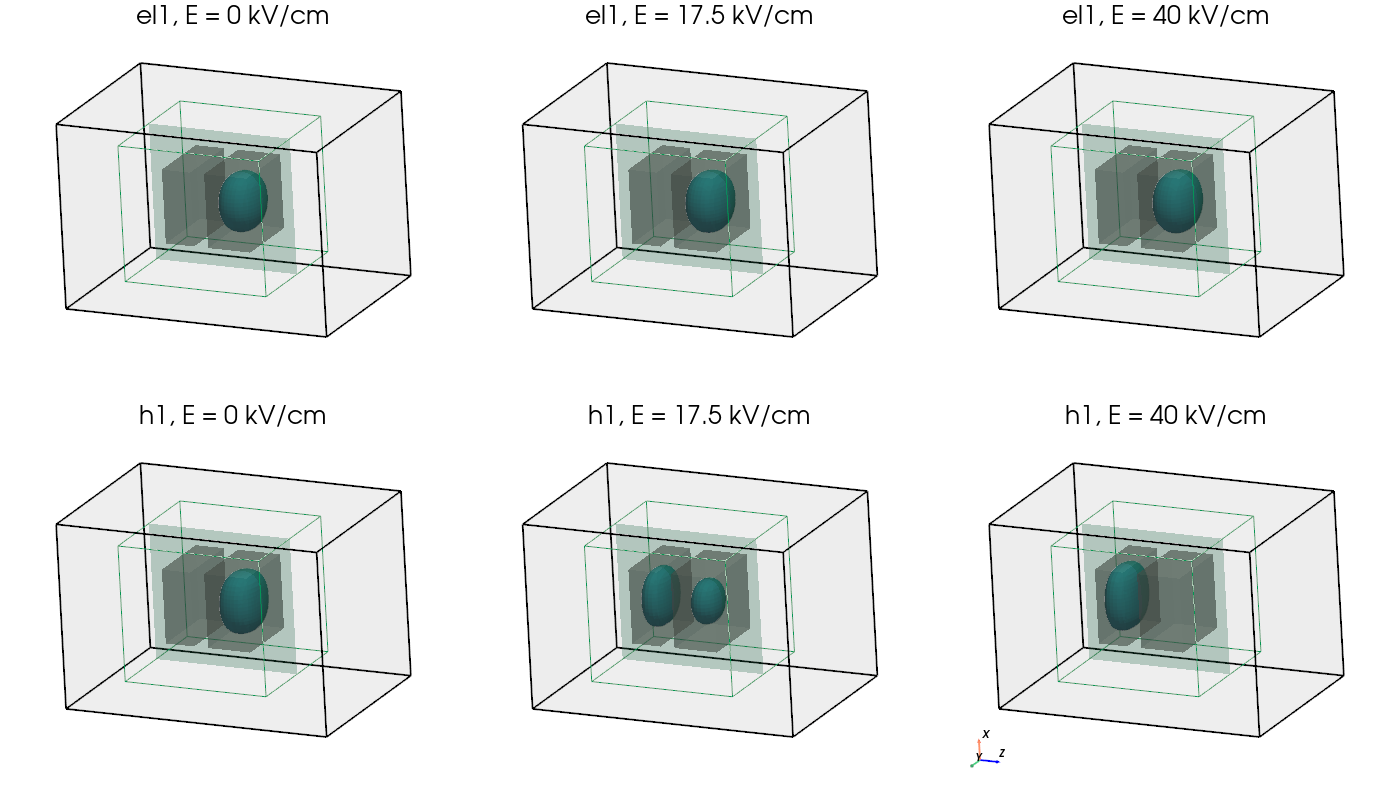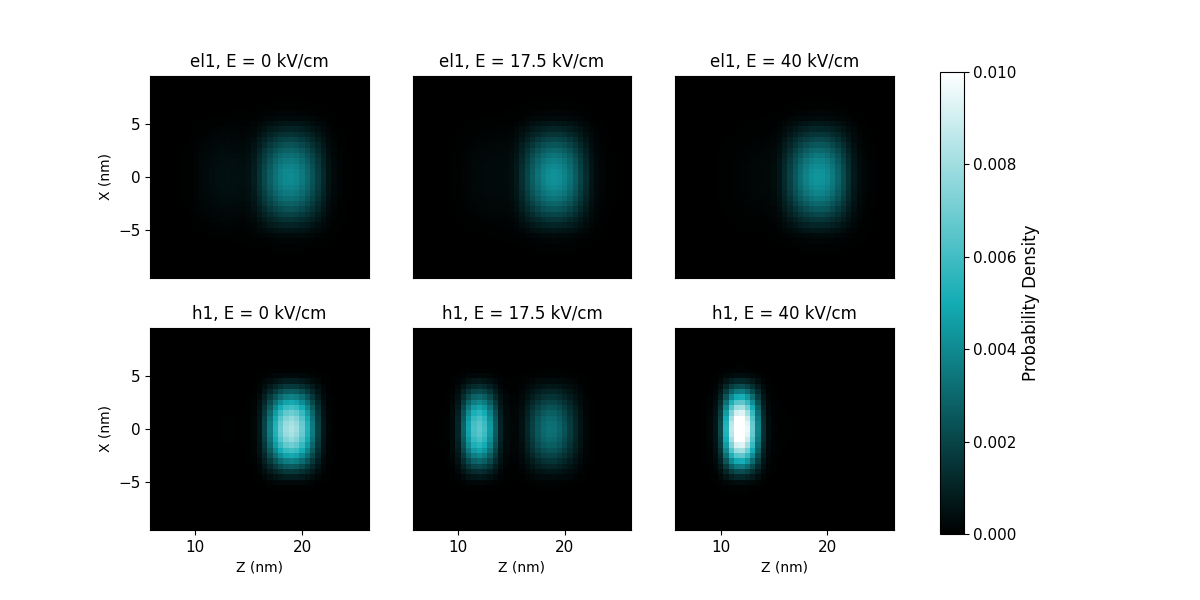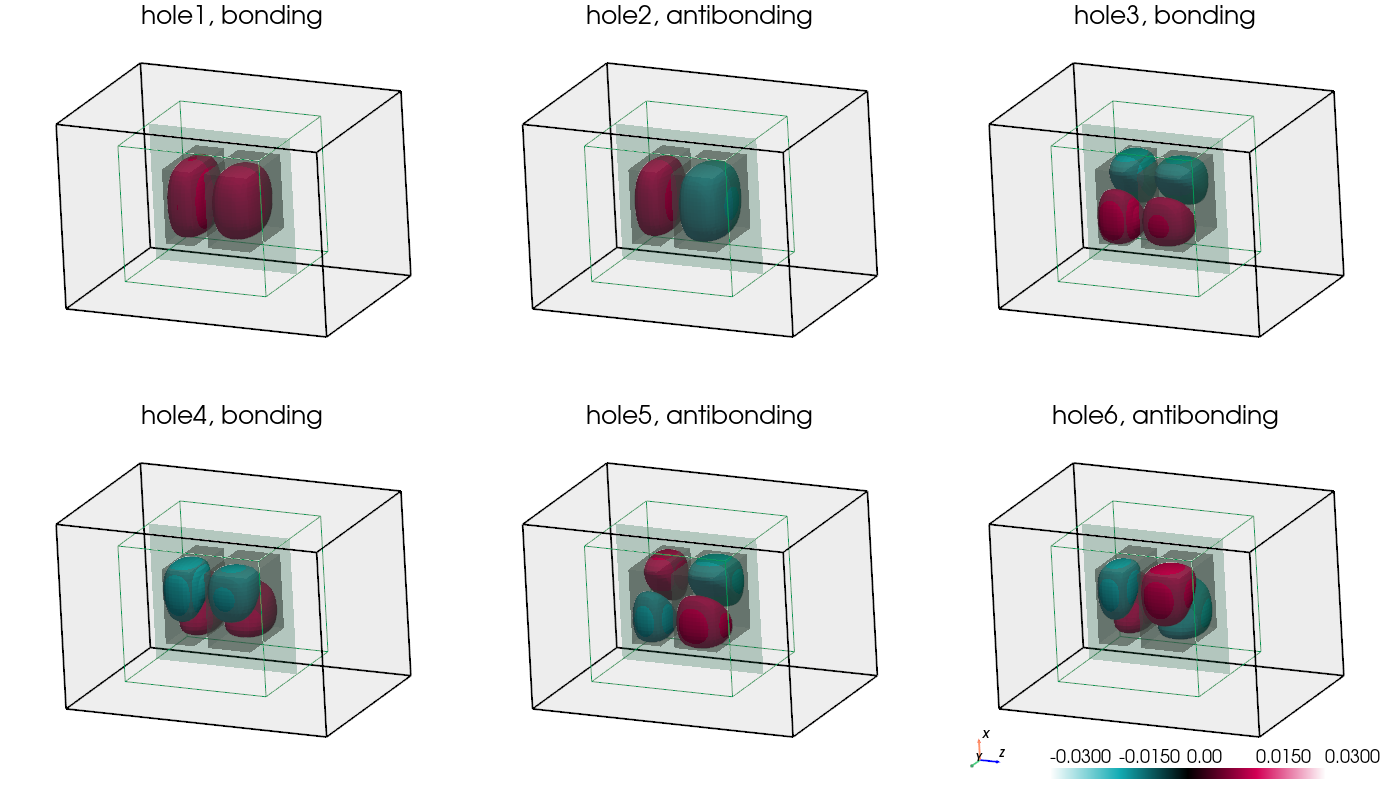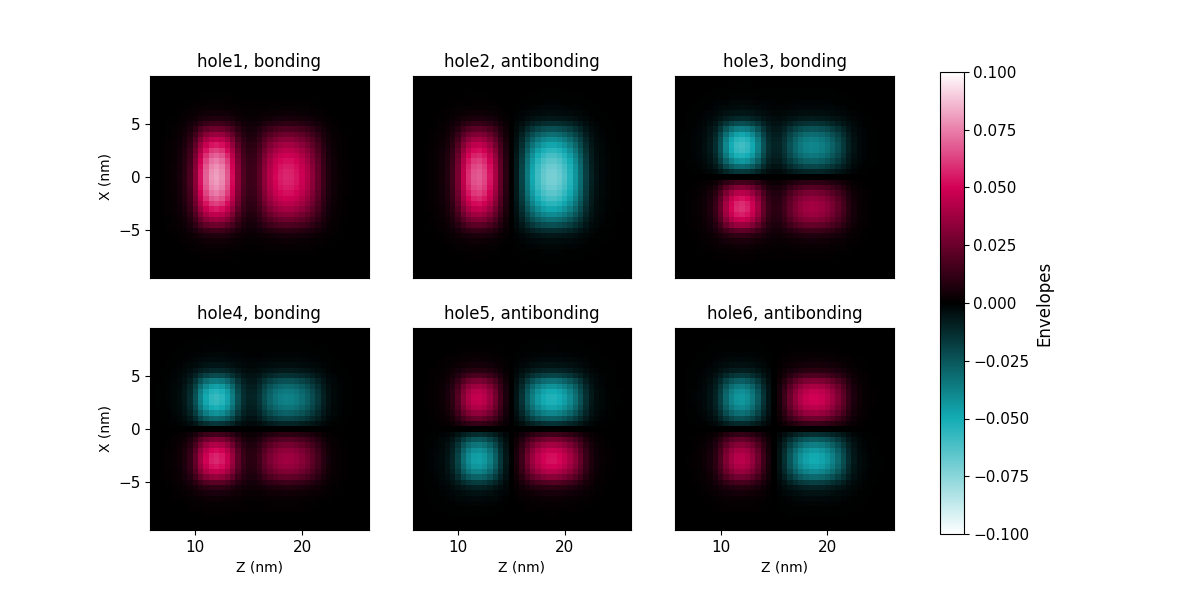5.10.6. Double Quantum Dot as an Artificial Diatomic Molecule
In this tutorial, we study two coupled quantum dots (QDs), i.e. two “artificial atoms” that form an “artificial molecule”. The two QDs are asymmetric and differ with respect to their height (4 nm and 6 nm).
With no electric field, the groundstates of both elcectron and hole are localized at the larger QD. By applying the electric field and increasing its strength, the hole groundstate becomes bonding state and then localizes at the smaller QD. At the same time the electron groundstate is still localized at the larger QD because of the weaker coupling between the two QDs due to the heigher barrier height. We will see this leads to the change from an direct exciton to indirect exciton.
The relevant input files are as followings:
3DQD_molecule_cuboid_asymmetric_nnp.nnp
Some of the material parameters that are used in this tutorial are based on the paper of
M. Grundmann, D. BimbergFormation of quantum dots in twofold cleaved edge overgrowthPhys. Rev. B 55 (7), 4054 (1997).
Simulation
This simulation has the following features:
We keep things simple by using cuboidal shaped GaAs QDs surrounded by Al0.35Ga0.65As barriers, i.e. we neglect strain and piezoelectric effects which is reasonable as the two materials GaAs and Al0.35Ga0.65As have pretty similar lattice constants.
We also neglect the wetting layers and excitonic effects.
In order to keep the CPU time to a minimum, we do not use the k.p approximation, i.e. we use for both electrons and the heavy hole a single-band effective mass approximation for the Schrödinger equation (parabolic and isotropic effective mass tensor). Nevertheless, this is sufficient to show some basic quantum physical effects of this QD molecule.
We use different electron and hole masses in the barrier and well material, respectively.
The left QD has the dimensions 10 nm x 10 nm x 4 nm (smaller dot). The right QD has the dimensions 10 nm x 10 nm x 6 nm (larger dot).
The two QDs are separated by a 2 nm Al0.35Ga0.65As barrier.
The grid resolution is 0.5 nm (rectangular tensor grid). This leads to a 3D Schrödinger matrix of dimension 50,225.
We apply Dirichlet boundary conditions to the Schrödinger equation, i.e. the wave functions are allowed to penetrate the following distances into the barrier material (on each side): - along the x and y directions: 4 nm - along the z direction: 4.5 nm
We vary the electric field along the growth direction (z axis) in steps of 2.5 kV/cm, i.e. from 0 kV/cm to 40 kV/cm. Note that the direction of the electric field is opposite to the z-direction.
Results
Electron and heavy hole ground states
The following figure show the square of the first electron (el1, top) and heavy hole (h1, bottom) wave functions (isosurfaces at \(\psi^2 = 0.0015\)) for different applied electric fields (0 kV/cm, 17.5 kV/cm, 40 kV/cm).

Figure 5.10.6.1 Probabilities of first electron and first heavy hole states at different electric fields. The green wireframe shows the quantum region, the grey shaded areas are the quantum dots. The shown isosurfaces are at \(\psi^2 = 0.0015\). The shaded green slice is at \(y = 0\), i.e. through the center of the QDs.
The following figure shows the electron (el1, top) and heavy hole (h1, bottom) probabilities from the 2D slices defined in Figure 5.10.6.1 at different electric fields.

Figure 5.10.6.2 2D slices at \(y = 0\) of probabilities of first electron and first heavy hole states at different electric fields.
At zero applied electric field, both electron and heavy hole are located in the larger dot and form a direct (bright) exciton.
At an electric field of 17.5 kV/cm, the electron is still located in the larger dot on the right side, whereas the heavy hole located in both wells (strong coupling). The heavy hole states at the field of 17.5 kV/cm are discussed further below. The exciton that is formed is something in between a direct and an indirect exciton.
At an electric field of 40 kV/cm, the electron is still located in the larger dot on the right side, whereas the heavy hole ground state is now located in the left QD. An indirect (dark) exciton is formed. The exciton is called dark because the electron-hole overlap is much smaller and thus its oscillator strength (probability of optical transition) is much weaker (see Figure 5.10.6.6 below on spatial electron-hole overlap integrals).
Electron and heavy hole energies
Figure 5.10.6.3 shows the electron (left) energies of the ground state (e1) and the first excited electron state (e2) of the QD molecule, as well as the heavy hole (right) energies of the ground state (h1) and the excited hole states ( h2-h5 ) of the QD molecule. The electron ground state (e1) is always located in the larger QD (right side) whereas the first excited electron state (e2 ) is always located in the smaller QD (left side). The third and the forth eigenstate (e3, e4) are degenerate (not shown) because our QD molecule has a symmetry with respect to the x and y coordinates. They are always located in the right QD. In contrast to the electrons, the hole coupling between the two QDs is much stronger due to the smaller barrier height. At 17.5 kV/cm anticrossing between the states occur due to the formation of bonding and antibonding states.
Figure 5.10.6.3 Electron (left) and heavy hole (right) energies
Bonding and antibonding heavy hole state at anticrossing point
The following figure shows the envelopes of the first six hole wave functions (isosurfaces \(\psi=\pm 0.015\)) at an electric field of 17.5 kV/cm.

Figure 5.10.6.4 Envelope of the first 6 hole states at electric field of 17.5 kV/cm (some are bonding and some are antibonding states). The green wireframe shows the quantum region, the grey shaded areas are the quantum dots. The shown isosurfaces are at \(\psi = \pm 0.015\). The shaded green slice is at \(y = 0\), i.e. through the center of the QDs.
The following figure shows hole envelopes from the 2D slices defined in Figure 5.10.6.4.

Figure 5.10.6.5 2D slices at \(y = 0\) of envelopes of the first 6 hole states at electric field of 17.5 kV/cm (some are bonding and some are antibonding states).
Electron-hole transition energies and overlap
To understand the strength of the optical transitions we have to evaluate the matrix elements of the envelope functions, i.e. the spatial overlap integral over the electron and hole wave functions.
\[\int \psi_{el,i}^*(x)\psi_{hl,j}dx\]
The following figure shows the five lowest electron-hole transition energies of the QD molecule as a function of electric field (left) and the overlap between the first electron (el1) and the first and second heavy hole (h1 and h2) wave functions (right).
For fields smaller than 17.5 kV/cm a direct (bright) exciton is the ground state (both electron and hole wave function are located in the larger QD (right side), whereas for fields larger than 17.5 kV/cm an indirect (dark) exciton is the ground state where the electron is located in the larger QD (right side) and the hole is located in the smaller QD (left side). Therefore, the nature of the QD molecule ground state changes from direct to indirect.
Figure 5.10.6.6 Electron-hole transition energies (left) and overlap (right) as a function of electric field.
This tutorial also exists for nextnano³.
Last update: 2025-10-16